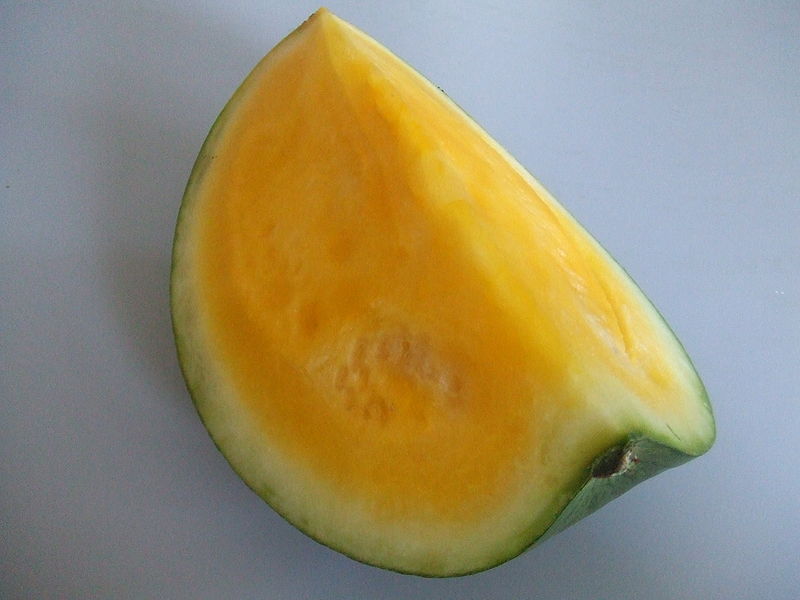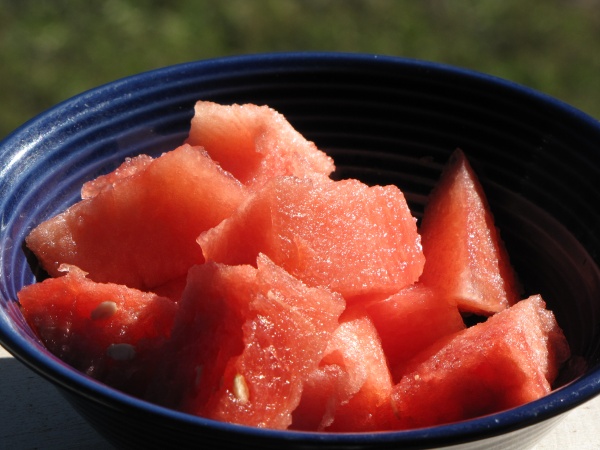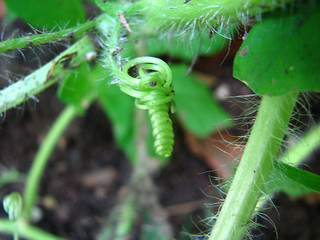Adaptation
Living in such warm weather has allowed some obvious morphological features on the watermelon. The rind is very thick in order to keep the Citrullus lanatus from drying out. Too much water loss would result in lack of nutrients and make the watermelon incapable of growing. The vines are also very long and tend to wrap around anything it can get a hold of. This increases the surface area and allows for maximum photosynthesis. Other adaptations have also evolved with the presence of humans and is discussed further down in the page; but first start out by learning a little bit of watermelon history.
Brief history
Watermelons originated in Africa, but in the 1500’s it
also naturally grew in the Middle East,
 Central Asia, Mediterranean
Coasts, Europe. Not too long after, the growth of this organism spread
to Japan, as Japan is very close to South China and Southeast Asia. Both
humans and animals from these countries used the watermelon regularly in
their diets. The popularity of the watermelon resulted in it being a
common food crop that was traded worldwide. In the 1600’s, it had spread
to multiple other countries including the USA, adapting to warm climates
with lighter soils. Rinds from the watermelon were used for pickles
preserves. However, watermelon before the 1900’s did not similarly
resemble the watermelon we see today in terms of size, shape, color, and
even nutritional value. This is because humans were not yet practicing
selective plant breeding, and all reproduction was natural.
Central Asia, Mediterranean
Coasts, Europe. Not too long after, the growth of this organism spread
to Japan, as Japan is very close to South China and Southeast Asia. Both
humans and animals from these countries used the watermelon regularly in
their diets. The popularity of the watermelon resulted in it being a
common food crop that was traded worldwide. In the 1600’s, it had spread
to multiple other countries including the USA, adapting to warm climates
with lighter soils. Rinds from the watermelon were used for pickles
preserves. However, watermelon before the 1900’s did not similarly
resemble the watermelon we see today in terms of size, shape, color, and
even nutritional value. This is because humans were not yet practicing
selective plant breeding, and all reproduction was natural.
Selective plant breeding
Selective plant breeding is the physical process where
humans control the specific traits that the offspring of a particular
plant has. This process began with watermelons in the 19th century and
is still actively going on today. Because of the breeding, watermelons
are found with different appearances. They can be found seeded, seedless, with pink flesh, yellow flesh, or green flesh. The
types of watermelon are usually grouped together, and often differ based on the
country it’s growing in.
century and
is still actively going on today. Because of the breeding, watermelons
are found with different appearances. They can be found seeded, seedless, with pink flesh, yellow flesh, or green flesh. The
types of watermelon are usually grouped together, and often differ based on the
country it’s growing in.
Selective breeding is quick and allows for a high number of fruits
per plant and a large amount of seeds per fruit. It also allows the
production of a different variety of watermelon. Breeders can control
factors such as earliness, size, shape, strength of rind, sugar content,
texture of the flesh, disease resistance, and heat tolerance. All of
these factors are worked towards increasing quality and life span. One
of the most popular crossings involves the production of the seedless
watermelon.
Seedless Watermelon
 In its natural state, the watermelon produces seeds, however with
selective plant breeding; humans have made the adaptation of no black
seeds. The seedless watermelon was invented over 50 years ago. In order
to create a seedless watermelon, a diploid plant (22 chromosomes), and a tetraploid plant (44 chromosomes) must be crossed. This crossing results
in the production of a triploid seed (33 chromosomes), which forms into
a seedless watermelon. The downside to this crossing, however, is
triploid seeds are sterile. This means that they are incapable of producing
seeds, and can therefore not reproduce.
In its natural state, the watermelon produces seeds, however with
selective plant breeding; humans have made the adaptation of no black
seeds. The seedless watermelon was invented over 50 years ago. In order
to create a seedless watermelon, a diploid plant (22 chromosomes), and a tetraploid plant (44 chromosomes) must be crossed. This crossing results
in the production of a triploid seed (33 chromosomes), which forms into
a seedless watermelon. The downside to this crossing, however, is
triploid seeds are sterile. This means that they are incapable of producing
seeds, and can therefore not reproduce.
How does the watermelon move?

Being a plant, the watermelon is immobile, and therefore all of its "movement" is growth/enlargement. In order to increase surface area, however, it participates in both primary and secondary growth, just like the sunflower. This means its stems and roots can grow by elongating and by increasing the girth. Unlike animals, it contains totipotent tissue that allows it to grow through out its entire life gaining as much surface area as possible. More surface area increases diffusion, which allows plants to acquire a maximum amount of nutrients.
Nutrients are very important for survival, find out all about them under nutrition!